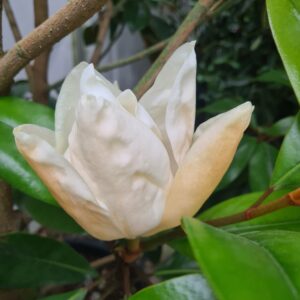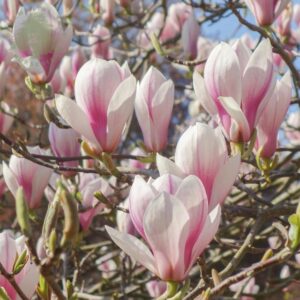Magnolia kobus
Price range: £65.00 through £600.00
Frequently Bought Together




Description
Quick Facts
- Common Name: Northern Japanese Magnolia, Kobus Magnolia
- Botanical Name: Magnolia kobus
- Plant Type: Deciduous tree
- Mature Height: 8-12m
- Mature Spread: 6-10m
- Flowering Period: March to April
- Flower Colour: Pure white with slight pink flush at base
- Foliage: Obovate leaves, mid-green turning yellow-bronze in autumn
- Hardiness: RHS H6 (hardy)
- Soil Requirements: Moist, well-drained, slightly acidic to neutral
- Aspect: Full sun to partial shade
- Maintenance: Low
Description
Experience the breathtaking elegance of Magnolia kobus, the stunning Northern Japanese Magnolia that brings spectacular early spring drama, delicate fragrance, and graceful presence to your garden with its profusion of pure white star-shaped flowers. This exceptional ornamental magnolia offers remarkable qualities—masses of beautiful pure white flowers measuring 10cm across that appear in early spring before the leaves, creating a stunning cloud of white blossom that signals the arrival of spring, delicate lemon-like fragrance that fills the garden on warm spring days, exceptional hardiness and reliability with flowers that are more frost-resistant than many other magnolias, and elegant pyramidal to rounded form that provides attractive structure throughout the year, making this one of the most reliable and graceful magnolias for creating early spring spectacle, fragrant beauty, and oriental elegance in.
Throughout early spring, this captivating tree becomes adorned with masses of beautiful star-shaped flowers measuring 8-10cm across with six narrow, slightly twisted petals (tepals) in pure white with a subtle pink or purple flush at the base. The flowers appear on bare branches before the leaves emerge, creating maximum visual impact—the entire tree becomes a cloud of white blossom that seems to float in the spring air. Each flower opens from elegant silky-grey furry buds and releases a delicate, sweet lemon-like fragrance on warm days. The flowers are more frost-tolerant than many magnolias, making this a reliable choice for gardens where late frosts can damage more tender varieties. As the flowers fade, the attractive obovate leaves measuring 8-15cm long emerge in fresh mid-green, creating dense foliage throughout summer. In autumn, the foliage transforms into warm shades of yellow-bronze before falling, and interesting cone-like seed pods develop, adding textural interest.
Native to Japan and Korea, Magnolia kobus is named after the Japanese botanist Kobus. This species is one of the hardiest and most reliable magnolias, thriving in cooler climates and tolerating more challenging conditions than many other magnolias. Hardy and adaptable once established, this magnolia thrives in British conditions when given appropriate shelter from harsh winds and planted in suitable soil. Unlike some magnolias that take many years to flower, Magnolia kobus typically begins flowering within 5-10 years from planting. The elegant pyramidal form when young gradually develops into a more rounded, spreading crown with age, creating attractive architectural presence.
Create stunning compositions by planting as spectacular specimen trees in lawns, woodland gardens, or prominent positions where the early spring blossom can be fully appreciated. Magnificent in oriental-style gardens, naturalistic landscapes, or as focal points in mixed borders. Works beautifully planted where the flowers can be viewed against a dark evergreen backdrop that enhances the pure white blooms, or positioned to be backlit by spring sun for maximum drama. Exceptional underplanted with spring bulbs like white and blue scilla, white narcissus, or blue muscari that complement and extend the spring display. Plant where sheltered from harsh winds and where the delicate fragrance can be enjoyed.
Caragh Garden Notebook
Planting: Space trees 8-10m apart if planting multiples, or allow 10-12m for specimen placement to accommodate the mature spread. Plant container-grown specimens year-round, though autumn or early spring is ideal. Dig holes twice the width of the root ball and incorporate generous amounts of organic matter or ericaceous compost. Plant at the same depth as the container—avoid planting too deeply. Choose sheltered positions protected from harsh winds and late spring frosts. Avoid planting in frost pockets. Water thoroughly and mulch generously with organic matter or composted bark, keeping mulch away from the trunk.
Soil Preparation: Thrives in moist, well-drained, slightly acidic to neutral soil with pH 5.5-7.0. Prefers fertile, humus-rich, moisture-retentive conditions enriched with generous amounts of organic matter or ericaceous compost. Dislikes waterlogged, very dry, shallow chalky, or alkaline soils—magnolias are susceptible to chlorosis (yellowing leaves) in alkaline conditions. Requires excellent drainage whilst maintaining consistent moisture. Best flowering and growth occur in full sun to partial shade with shelter from harsh winds and consistent soil moisture.
Container Growing: Young specimens can be grown in very large containers (minimum 70cm diameter) using ericaceous or soil-based compost for several years. Water regularly with rainwater if possible, especially in hard water areas. Feed in spring with slow-release ericaceous fertiliser. Protect containers from hard frost in winter. However, for best long-term health, spectacular flowering, characteristic form development, and mature size, plant out into the ground where the extensive root system can develop fully.
Seasonal Care: Requires minimal pruning—the naturally elegant form develops without intervention. Remove only dead, damaged, or crossing branches immediately after flowering in late spring—never prune in winter or autumn. Avoid creating large wounds as magnolias are slow to heal. If pruning is necessary, do so sparingly and only after flowering. Apply slow-release ericaceous fertiliser in early spring. Mulch annually with organic matter or composted bark to retain moisture, suppress weeds, and maintain soil acidity. Water during dry spells, especially in the first 5-7 years until well established. Magnolias have fleshy roots that are easily damaged—avoid cultivating around the base.
Propagation: Can be grown from seed collected from ripe seed pods in autumn, though seedlings take many years to reach flowering size (10-15 years) and may show variation. Sow fresh seed in autumn in ericaceous compost. Professional propagation is also by layering or grafting onto rootstock. Semi-hardwood cuttings can be attempted in summer with rooting hormone but success is variable. Home gardeners seeking reliable flowering within reasonable timeframes should purchase nursery-grown specimens.
This elegant beauty is absolutely stunning—those masses of pure white star-shaped flowers on bare branches in early spring are simply breathtaking! The delicate lemon fragrance is gorgeous, and the flowers are more frost-tolerant than many magnolias, making this so reliable for Irish gardens. Graceful pyramidal form, beautiful autumn colour, and begins flowering much sooner than many magnolias. Hardy, reliable, and pure spring magic!






